How to Scale SaaS Governance from 100 to 500 Employees
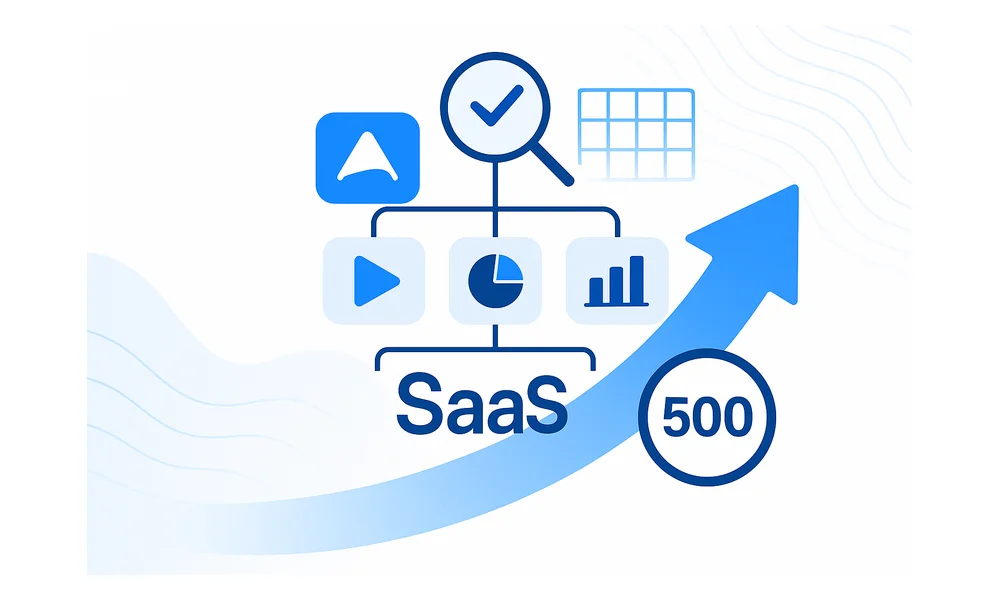
Rapid hiring can turn a tidy SaaS lineup into a tangled sprawl. Between 100 and 500 employees, teams grab tools for speed without much visibility, contract rigor, or security review. When that sprawl goes unchecked, budgets leak, data scatters, and auditors end up asking who owns each link to critical systems.
IT, security, and finance leaders feel the mess in different ways, but it traces back to governance that fell behind. Shadow spend climbs, risks pile up. Building a clear, repeatable framework now can curb costs, tame risk, and still let teams add apps when they need them. Overhauling workflows mid-growth still sounds daunting, especially when head count growth already strains bandwidth.
A four-step approach helps: audit the stack, formalize procurement, automate oversight, then track the right KPIs. Companies that follow it add structure without snuffing out innovation.
Table of Contents
- Audit and Categorize SaaS Stack
- Formalize Procurement Workflow
- Deploy Visibility and Discovery Tools
- Create SaaS Governance Council
- Track SaaS Governance KPIs
- Conclusion
- Audit your company's SaaS usage today
Audit and Categorize SaaS Stack
An accurate inventory beats guesswork when the team still fits on one office floor. Grab a snapshot of every license, login, and corporate-card charge touching company data before the next wave of hires slips in more shadow tools.
Stick with the records you already have; nobody finishes yet another questionnaire.
- SSO logs list every app that authenticated, including the free trial someone started yesterday.
- Corporate card and expense exports spot subscriptions billed outside IT’s line of sight.
- Browser plug-ins from discovery tools reveal personal accounts signed in with a work email.
Pull the three lists into one sheet, dedupe the app names, and you will have a working census before lunch.
Now classify each entry so later policy work lands in the right lane. Assign a primary business function first, such as marketing automation, design, or collaboration, then tag data sensitivity using a simple scale of public, internal, confidential, or regulated. Renewal date and contract value round out the basics. If you need an extra filter, add a “Tier” field: Tier 1 holds systems of record like CRM or payroll, while Tier 3 could be a free white-noise generator. The tiers guide different approval flows later and prevent you from chasing SOC 2 for a Spotify playlist.
A clear view of ownership and usage depth finally closes the loop. For every app, name one person who can answer, “Do we still need this?” pull raw login counts to gauge adoption; more than half of SaaS seats sit idle according to Productiv’s 2023 benchmark, so the waste adds up quickly. Okta’s Businesses at Work report shows firms with about 100 employees already juggle 89 apps, and in that crowd forgotten renewals slip through easily. Flag anything with fewer than five active users or zero logins in 60 days, and you will have a shortlist of shelfware before real governance even begins.
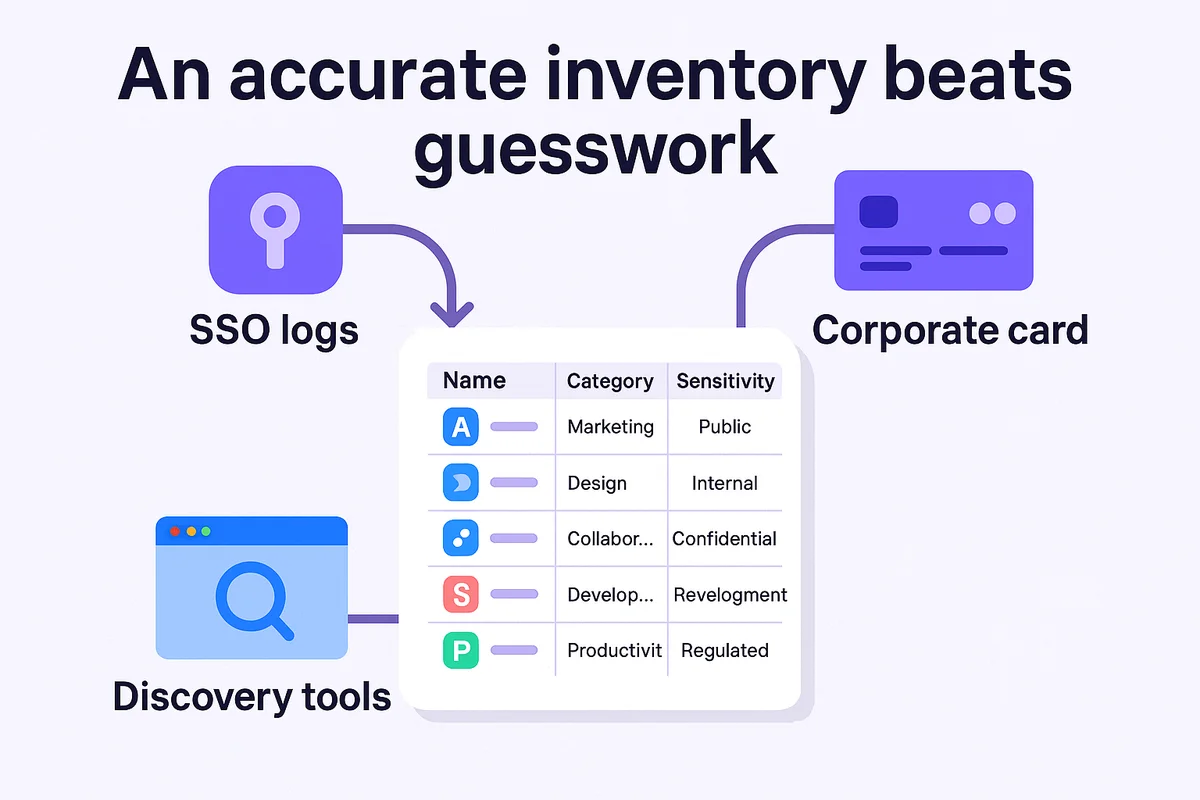
Formalize Procurement Workflow
Once every app is mapped, scattered card swipes should be replaced by a single, shared buying lane. The goal is speed with guardrails, not red tape, so start by dropping a lightweight request form into the tools employees already open, such as Slack, Teams, or a simple Google Form. Each submission should capture three essentials: the purpose, the type of data involved, and a rough spend estimate. Security and finance then see only what matters, trimming email threads from days to minutes.
Run those requests through a rules engine that pushes bigger risks uphill. Deals under $10,000 can go straight to department leads, while anything higher lands in finance for a numbers check and security for a questionnaire. Many teams script these checks in ServiceNow or a similar intake tool, but any ticket system with conditional logic works. Consistency matters; every deal, no matter how small, follows the same visible path so no one wonders who signed off six months later.
Lock down the paperwork so reviewers stop rebuilding the same clauses. A single-page DPIA covers data residency, a short DPA sets breach notice timelines, and a click-wrap order form clamps pricing in place. When 80 percent of the language never changes, legal reaches for the red pen far less, shrinking turnaround from weeks to hours. Attach the latest templates to the request form and refresh them each quarter; stale documents invite shadow agreements.
Renewals blow up budgets when they appear out of nowhere, so pin a timer to signature date plus ninety days. The workflow tool pings the app owner first, then finance, then the CIO. Those gentle nudges give teams time to review usage and bargain for a discount instead of rubber-stamping another year.
Even the best workflow fails if people dodge it, so launch the change like a product:
- Run a five-minute demo in every all-hands.
- Post a cheat sheet and pin it in Slack.
- Hand out coffee gift cards to the first ten people who submit a request correctly.
- Share monthly “fastest approval” stats to keep momentum.
A clear lane, short forms, and quick wins turn procurement from a silent hazard into a healthy habit.
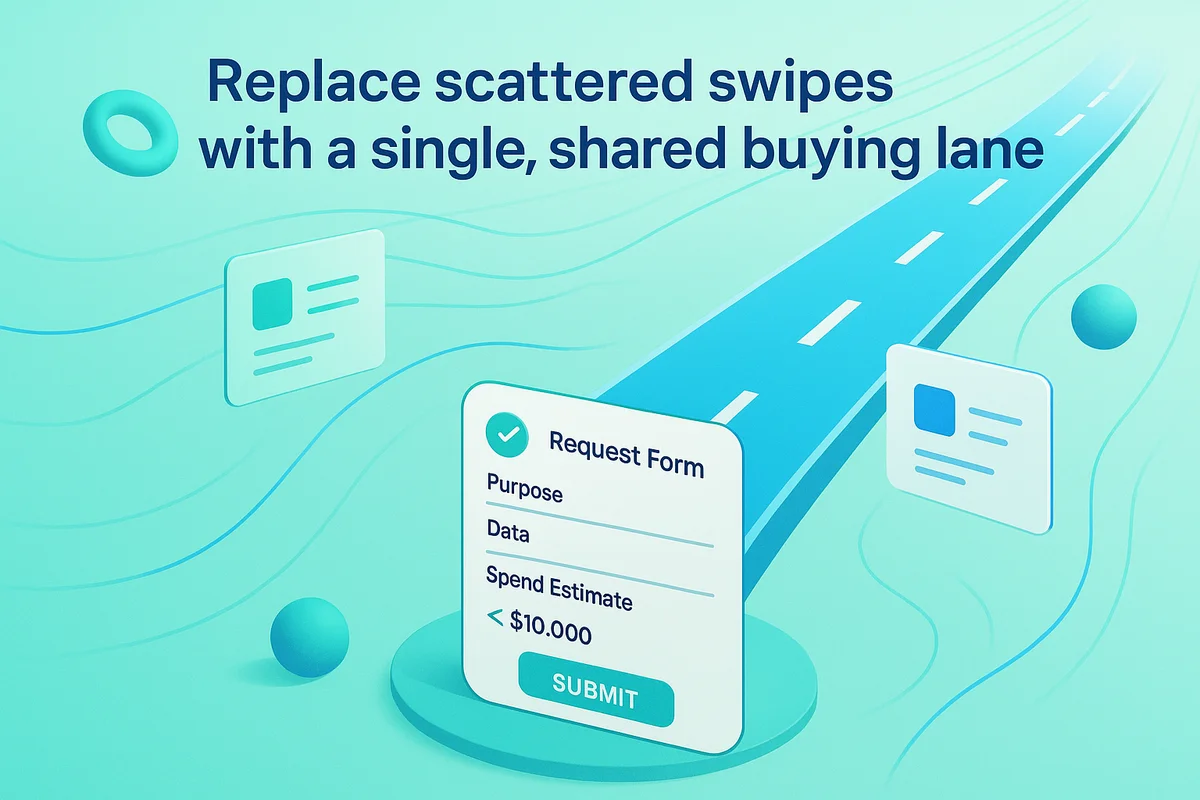
Deploy Visibility and Discovery Tools
Spreadsheets buckle when each new hire spins up three more SaaS seats. The priority shifts to live visibility, not a quarterly audit that’s outdated before the steering committee meets.
Three product families dominate the visibility market and each covers a different slice of the work:
- Cloud access security broker (CASB) tools such as Netskope watch network traffic and flag shadow SaaS in real time.
- SaaS management platforms (SMP) like Torii or BetterCloud mine finance, SSO, and email metadata to surface usage, spend, and renewal dates in one place.
- Identity-centric dashboards from Okta or Microsoft Entra ID piggyback on login events to track license allocation and automate off-boarding.
Most mid-market teams pick one primary platform and layer a second tool where gaps remain.
When shopping, demand four baseline features because they separate the strong contenders from the noise. The system must auto-reconcile invoices with active seats so shelfware shows up before QBRs. It should scan OAuth scopes and spotlight risky permissions employees grant without thinking. Look for click-to-revoke workflows; forcing IT to open five consoles for one de-provision wastes hours. Finally, require customizable renewal alerts that hit Slack, email, and your ITSM tool so no one misses the 90-day notice window.
Reliable insights start with reliable integrations that keep records aligned. Pull data directly from your HRIS to capture joiners, movers, and leaver the moment their status changes. Push expense data from NetSuite or Sage Intacct so you catch vendor charges that never touched SSO. Feed the combined results back into your identity provider, letting a single “terminate employee” action revoke access across Zoom, HubSpot, and every other connected app within minutes.
Budgets tighten fast at 250 employees, so phase the rollout. Month one, light up discovery only and validate data quality. Month two, switch on automated off-boarding for the top ten apps by spend. Quarter two, extend coverage to department-owned tools and add risk-scoring reports for the governance council.
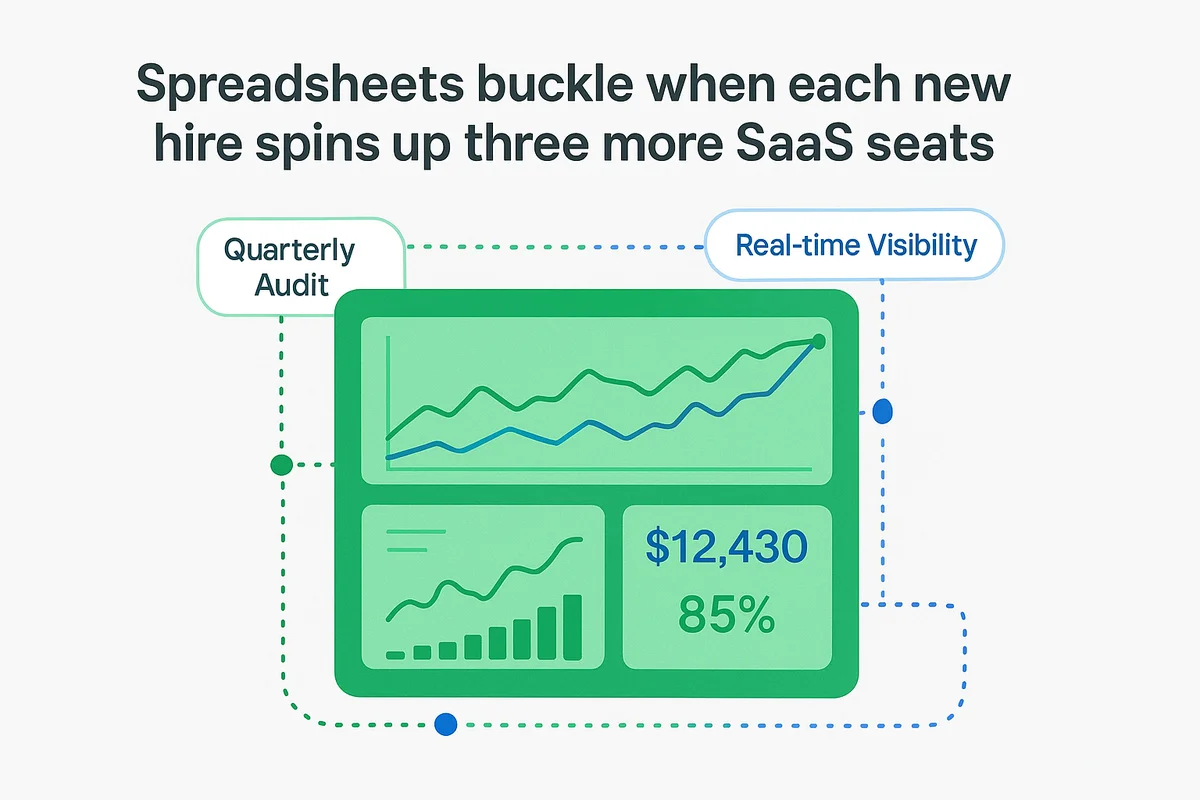
Create SaaS Governance Council
Shared ownership is mandatory once fifty teams can swipe a card and launch a new app. A cross-functional SaaS governance council channels that sprawl into managed growth by giving every department an actual seat at the table. Okta’s 2023 Businesses at Work report shows companies with about 500 employees juggle roughly 255 apps, a load IT cannot police alone.
The lineup of stakeholders matters just as much as the rules themselves. Bring in one decision maker from IT, security, finance, procurement, and any revenue-generating unit with a serious software budget. Voting power need not be equal, yet each role must have documented decision rights so approvals do not stall during hand-offs. Post those rights on the intranet and revisit them whenever headcount or regulations change.
Meetings stay short when the prep work is genuinely tight. Send a consolidated app dashboard forty-eight hours ahead, and use the live session only for exceptions, risks, or conflicts. Typical standing agenda items for the governance council might look like:
- Triage new app requests within two business days to keep teams moving fast
- Review data residency and compliance impacts before any contract is signed
- Track overlapping functionality and champion consolidations during quarterly reviews
- Report cost, risk, and usage metrics to executives in one-page snapshots
Cutting spend is popular, yet savings alone rarely fire up line-of-business leaders. Tie victories to their world: reallocate 50 percent of any avoided spend to the originating department’s discretionary budget or next-year headcount plan. Zylo’s 2022 benchmark found 38 percent of paid licenses sit unused; turning even half of that waste into team funding builds instant allies.
Visible victories have a way of cementing good habits across teams. Rotate the chair each quarter, celebrate the fastest de-provision turnaround on Slack, and share a before-and-after spend chart with the board. People copy what gets praised, so every shout-out reinforces that the council is not another gate; it is the simplest path to secure, cost-effective software for a company that keeps doubling in size.
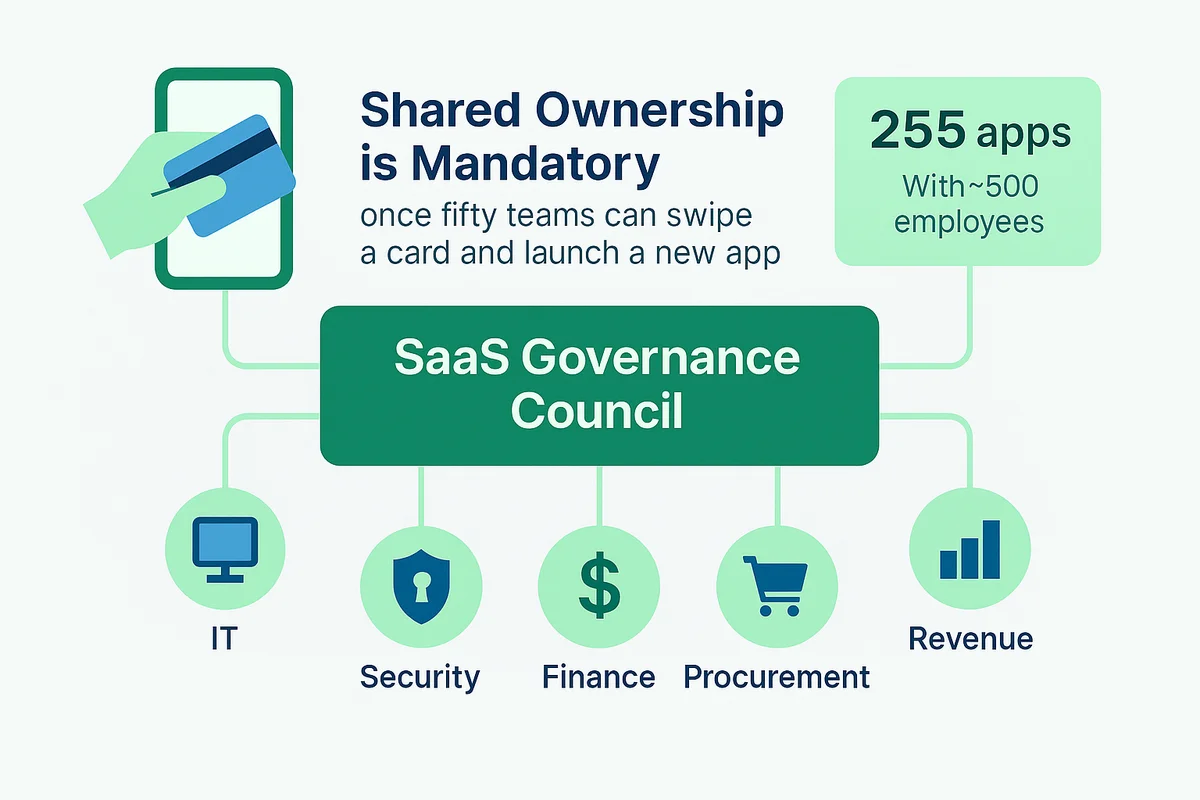
Track SaaS Governance KPIs
Clear targets turn SaaS governance from a policy document into a living system that grows with the company headcount.
Start by tracking five metrics that reveal cost, risk, and operational drag.
- Spend per employee
- License use percentage
- Mean time to provision or de-provision an account
- Risk assessment completion rate before an app goes live
- Number of redundant apps retired each quarter
Capture a three-month baseline, then set stretch goals you can hit within two quarters; traction matters more than perfection. If the average company in your peer set spends 240 dollars per employee each month, shoot for 220 first, not 150. A modest win funds better tools and keeps department owners engaged.
Dashboards need to live in the tools decision-makers already use. Pushing daily feeds from your SaaS management platform into Power BI or Slack cuts the friction of yet another portal. Make every widget actionable: red when license waste exceeds ten percent, yellow between five and ten, green below five. Long bars of unused seats flagged in orange will do more to spark a renewal conversation than a polite email from finance. That simple splash of color nudges managers to act, because no one wants their name attached to a bright orange block sitting idle for weeks.
Numbers alone won’t fix sprawl, so pair them with a steady inspect-and-adapt cycle. The governance council should review KPI deltas monthly, pick one blocker to remove, and assign a clear owner before the meeting ends. Tie any realized savings back to team budgets within the quarter; nothing motivates compliance like seeing freed cash reallocated to headcount or marketing experiments. Finally, share scoreboard snapshots in the company all-hands so employees cheer the thirty-six-hour drop in de-provision time instead of wondering why their favorite tool vanished.
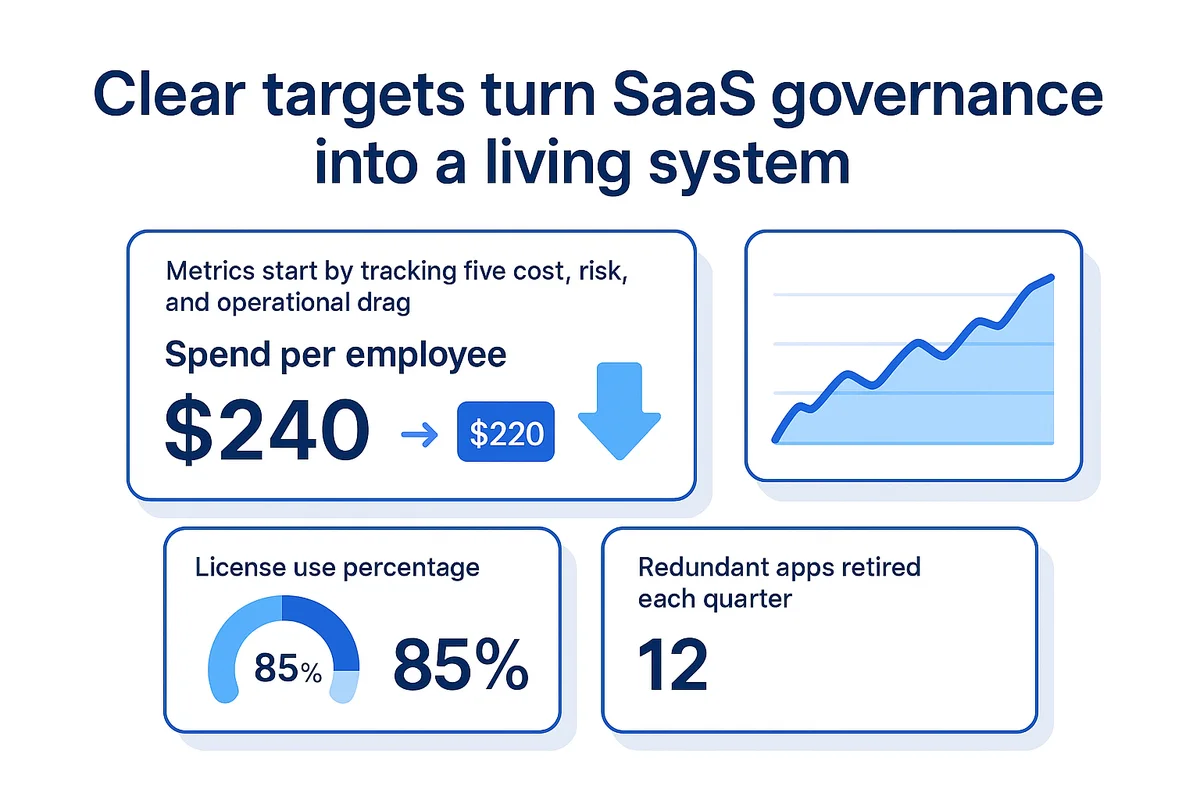
Conclusion
Hitting 500 employees in what feels like an instant can turn SaaS sprawl into a genuine operational headache. Begin by auditing every license, directing card-swipe purchases through a lightweight procurement check, adding discovery tools, assembling a small governance crew, and tracking outcome KPIs so you maintain control without slowing the team. Each step reinforces the next; visibility informs process, process guides tooling, and shared metrics keep everyone aligned as headcount keeps climbing.
Audit the stack, lock in purchasing gates, automate watchpoints, and measure often. That focused loop keeps SaaS safe while you scale.
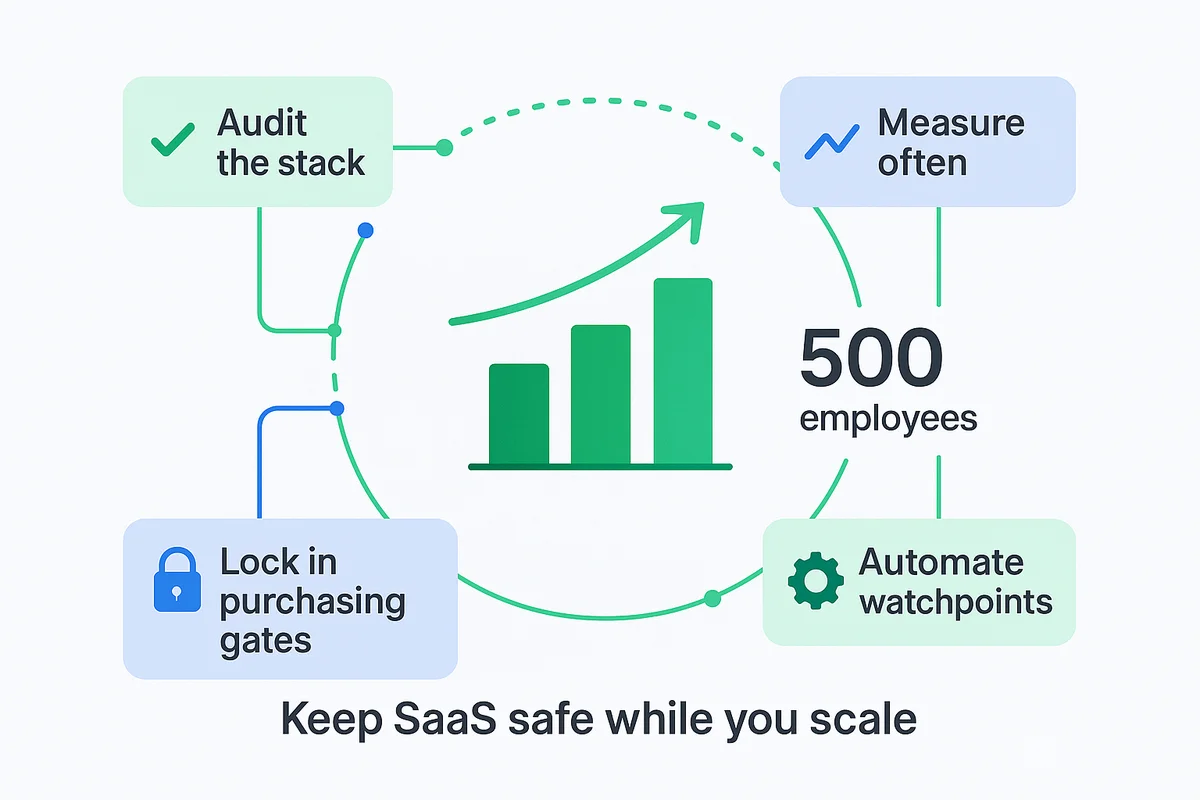
Audit your company’s SaaS usage today
If you’re interested in learning more about SaaS Management, let us know. Torii’s SaaS Management Platform can help you:
- Find hidden apps: Use AI to scan your entire company for unauthorized apps. Happens in real-time and is constantly running in the background.
- Cut costs: Save money by removing unused licenses and duplicate tools.
- Implement IT automation: Automate your IT tasks to save time and reduce errors - like offboarding and onboarding automation.
- Get contract renewal alerts: Ensure you don’t miss important contract renewals.
Torii is the industry’s first all-in-one SaaS Management Platform, providing a single source of truth across Finance, IT, and Security.
Learn more by visiting Torii.
Frequently Asked Questions
Rapid hiring can lead to SaaS sprawl, where unmonitored tools increase costs, data disorganization, and ownership confusion, affecting IT, security, and finance.
Companies should gather data from SSO logs, expense reports, and browser plugins to create a comprehensive inventory of all applications in use.
The goal is to create a streamlined purchasing process that allows for quick approvals while maintaining visibility, thus reducing inefficiencies and potential risks.
Automation enhances oversight, ensuring continuous visibility and timely alerts for renewals and compliance, which helps prevent costly oversights.
A SaaS governance council includes stakeholders from various departments to collaboratively manage software usage, streamline processes, and oversee compliance.
Key KPIs include spend per employee, license usage percentage, and the average time for provisioning or de-provisioning accounts.
By conducting regular audits, formalizing procurement processes, automating tracking, and establishing a governance council, organizations can manage and contain SaaS sprawl.

